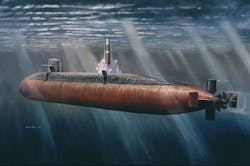Lockheed Martin prepares to build another batch of Trident submarine-launched ballistic missiles
WASHINGTON, 19 July 2016. U.S. Navy strategic weapons experts are preparing to buy another batch of submarine-launched nuclear ballistic missiles that are capable of destroying city-sized targets virtually anywhere in the world.
Officials of the U.S. Navy Strategic Systems Program Office in Washington announced a $21.8 million contract last week to the Lockheed Martin Space Systems segment in Sunnyvale, Calif., for long lead items to support the fiscal 2017 Trident II D5 missile production schedule.
The Trident II D5 is one of the most advanced submarine-launched atomic missiles in the world. Each Trident II missile has a range of 4,000 to 7,000 miles. The Trident II D-5 was first deployed in 1990 and is scheduled to remain in service until at least 2027.
Long-lead items involve system components that require the longest time to build, which could delay overall system production if money isn't allocated for production early in the process.
The Trident II D-5 is the primary U.S. sea-based nuclear ballistic missile, and is deployed aboard U.S. Navy Ohio-class ballistic missile submarines.
The U.S. Navy operates 14 of these ballistic missile submarines, each of which can carry as many as 24 Trident II missiles. Although the Trident II is designed to carry as many as 12 multiple independently targetable reentry vehicle (MIRV) warheads, current treaties reduce this number to four or five.
The Navy started the D-5 Life Extension Program in 2002 to replace obsolete components using as many commercial off-the-shelf (COTS) parts as possible to keep costs down and to enhance the missile's capability.
The Charles Stark Draper Laboratory Inc. in Cambridge, Mass., is in charge of upgrading the Trident II's guidance system, and has been working on this project since 2005.
story continues below
In practice, the Trident II missile's inertial measurement system receives targeting data from computers aboard the submarine. The inertial measurement unit then transmits signals to the D-5 flight-control computer and converts them into steering commands to keep the ballistic missile on target.
The missile's post-boost control system maneuvers the missile in flight to observe stars for the missile's celestial navigation subsystem, which updates the inertial system in flight.
Lockheed Martin also is integrating the Trident II onto the next-generation ballistic submarine designs of the U.S. and United Kingdom by adapting the Trident II missile and reentry subsystems into the common missile compartment for the Ohio replacement and United Kingdom successor programs.
The Ohio replacement is being designed to replace the Navy's fleet of Ohio-class ballistic missile submarines. The United Kingdom successor program, meanwhile, will replace the Royal Navy's fleet of Vanguard-class ballistic missile submarines.
Related: Navy invests in submarine-launched nuclear ballistic missile guidance upgrades and test
Lockheed Martin won a potential $1.48 billion Navy contract for new Trident II (D5) missiles, D5 life extension development, and production, and D5 deployed systems support.
On last week's contract for Trident II D5 ballistic missile long-lead items, Lockheed Martin will do the work in Sunnyvale, Calif., and should be finished by September 2021.
For more information contact Lockheed Martin Space Systems online at www.lockheedmartin.com/us/ssc, or the Navy Strategic Systems Program office at www.ssp.navy.mil.
Learn more: search the Aerospace & Defense Buyer's Guide for companies, new products, press releases, and videos

